Mail Art History: The Fluxus Factor by Ken Friedman
in: Mail Art Then and Now, The Flue, Vol. 4, No. 3-4 (special issue), 1984 Winter, pp. 18-24. | magyar megjelenés: Balkon, 2003/No. 12.
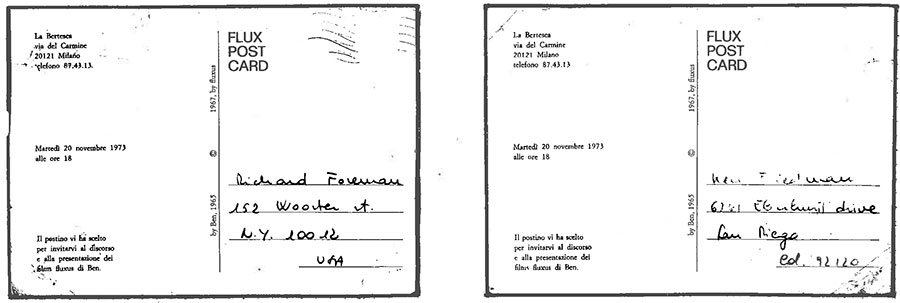
BEN VAUTIER, POSTMAN'S CHOICE. 1973 reissue of a 1966-67 post card printed by Fluxus based on a 1965 work by Ben. This mail art work involved the issues of choice and chance. Ben simply addressed both sides of the post card and left it up to the post man as to which of the two addresses would receive it. It was received by Ken Friedman. The Gilbert and Lila Silverman Collection.
It would be difficult to pinpoint the moment when artists' correspondence became correspondence art. By the end of the late 1950's, the three primary sources of correspondence art were taking shape. In North America, the New York Correspondence School was in its germinal stages in the work of artist Ray Johnson and his loose network of friends and colleagues. In Europe, the group known as the Nouveau Realistes were addressing radical new issues in contemporary art. On both continents, and in Japan, artists who were later to work together under the rubric of Fluxus were testing and beginning to stretch the definitions of art.
Correspondence art is an elusive art form, far more variegated by its very nature than, say, painting. Where a painting always involves paint and a support surface, correspondence art can appear as any one of dozens of media transmitted through the mail. While the vast majority of correspondence art or mail-art activities take place in the mail, today's new forms of electronic communication blur the edges of that forum. In the 1960's, when correspondence art first began to blossom, most artists found the postal service to be the most readily available - and least expensive - medium of exchange.
Today's micro-computers with modern facilities offer anyone computing and communicating power that two decades ago were available only to the largest institutions and corporations, and only a few decades previous weren't available to anyone at any price. Transistors and miniaturized electronics make it as simple today to record and to send a video-tape as to write a letter. With teletext, interactive cable, mailgrams, electronic mail, electronic computer networking, video, inexpensive audio, and - looming on the horizon - a myriad of new communications techniques, correspondence art is harder to define than ever before.
While these facts establish a sense of perspective, the soul of correspondence art remains communication. Its twin faces are "correspondence art" and "mail-art." Here the distinction is between reciprocal or interactive communication – correspondence - and unidirectional or one -way communication, mailed out without any requirement for response.
There are special wrinkles in correspondence art that involve the mails as medium of transmission for purposes other than mail-art. The best example of this would be an exhibition of art from Eastern Europe in which the cheapest and safest way of sending art to the United States would be through the mail, though the art works sent would actually be intended as -and only as - photographs, drawings, paintings, or artists' books.
Certain forms of art have become associated with correspondence art and mail art both by virtue of tradition and the ease with which they are mailed. These include post cards, artists' books, printed ephemera, rubber stamps, artists' postage stamps, and posters of various kinds.
The first phase of correspondence art primarily involved individual expression in reciprocal relationships, a natural outgrowth of artists' correspondence. History and tradition list Ray Johnson as the central figure in this phase of correspondence art. To the degree that he identified, named and himself became identified with the emerging art form, this is true.
Working in the tradition of collage and the objet trouve, he was perhaps the first to identify the transaction of art works and notes with colleagus as an art form itself. Through this stroke of inspiration, correspondence art was born. Johnson gave it focus by promulgating the rubric, "The New York Correspondence School of Art."[1] Thus, by permutation, the world was given the new medium, correspondence art, and its first body of practitioners, The New York Correspondence School (NYCS).
However, correspondence art as such first grew from the work of the European artists identified as the "Nouveaux Realistes," a term coined for them by French critic Pierre Restany. The core issue of the "New Realism," a movement born in the early '50's, was the conception of an art made of real elements, that is, materials taken from the world directly rather than pictorially. The group includes Arman, Yves Klein, Piero Manzoni, Martial Raysse, Raymond Hains, Daniel Spoerri and Francois Dufrene, and - in some senses - Christo. As one can see, these artists each use a rather direct slice of life. The actual sectioning ranges from the highly tenuous or theoretical projects of Manzoni and Klein to the embedded and snared works of Arman and Spoerri, the decollages of Hains and Dufrene and the world-embracing, massively realized projects of Christo.
The issues and ideas that motivated the Nouveaux Realistes also emerged in the Pop Art of the late '50's and early '60's in Britain and the United States, though Pop Art tended to be an art which took the real into its scope emblematically rather than by direct incorporation or manipulation.
The college sensibility and incorporation of the real are attitudes shared with much later correspondence art. It is in the use of the postal system, of artists' stamps and of the rubber stamp that Nouveaux Realisme made the first gestures toward correspondence art and toward mail art.
Several early key works in these media were created by these artists. Klein's famous Blue Stamp was a postal cause celebre and a bureaucratic scandal after it was successfully mailed and postmarked in the mid-50's. Arman introduced the rubber stamp into contemporary art with his cachets and accumulations of the early and middle years of the decade.[2] Spoerri not only created ephemeral mailed works and projects, small gazettes and cards, but his involvement with mail-art - unlike that of Klein or Arman - continued unabated for over a decade and a half spanning all the phases of correspondence art.
Thus, it can truthfully be said that the first artists involved in mail-art were the Nouveaux Realistes. However, it was Ray Johnson and his circle of friends in the New York Correspondence School who gave the first phase its characteristic sensibility and presence.
If the Nouveaux Realistes created paradigms of correspondence art and mailed art as works, it was the New York Correspondence School that took the notion from paradigm to practice. Ranging at times from seventy-five to as many as three hundred people, the NYCS was summoned into being by Ray Johnson but, at its height, existed around him as many intersecting relationships independent of his direct involvements. Many distinguished artists participated in Johnson's whirling vortex of mailings and events, some of whom, such as Richard C, Ed Plunkett, or Dick Higgins and other Fluxus artists became themselves major shapers of the ethos and attitudes of correspondence art.
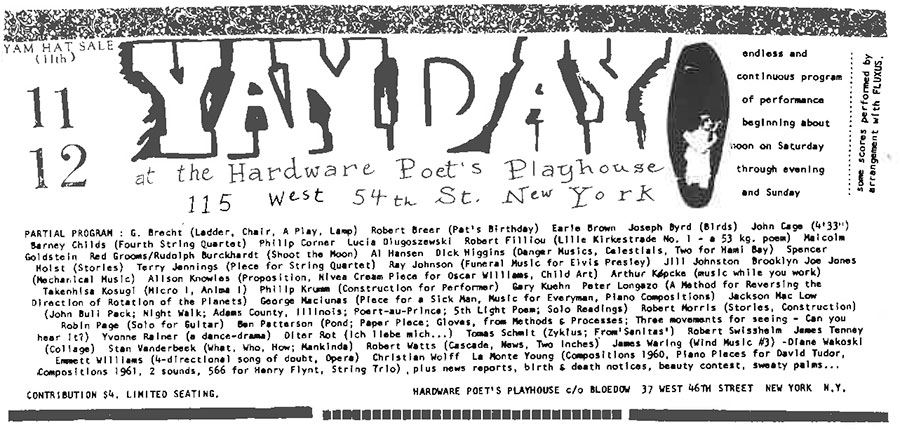
YAM FESTIVAL. ANNOUNCEMENT. 1962. YAM was a multimedia mail and performance art event, which as this announcement indicates brought together a variety of artists, ranging from George Brecht, Robert Watts, Alison Knowles, Dick Higgins, Ray Johnson who were among the well known figures in mail art circles, to sculptor Robert Morris, dancer Yvonne Rainer and composer La Montey Young. What did YAM stand for? Nothing more esoteric than MAY spelled backwards. Ed Plunkett Collection.
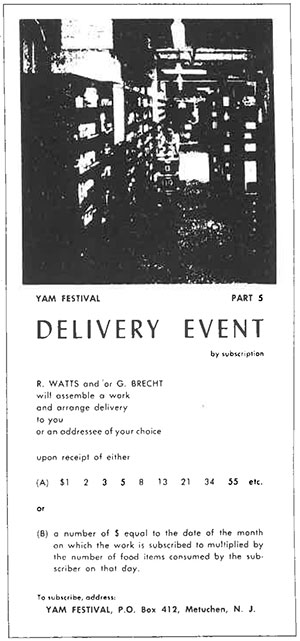
R. WATTS AND G. BRECHT. YAM FESTIVAL DELIVERY EVENT.
The Gilbert and Lila Silverman Collection.
The NYCS relied on direct interaction between correspondents. As a result, the works that one might receive in the early days were highly personal, often highly crafted. Hand-made collages, carefully printed photographs, even framed paintings were fairly common. Odd and lavish objects were not uncommon. Some participants took pride and even a perverse pleasure in sending to one another the most outlandish and possibly unmailable objects or series of projects they could conceive. My fondest memories are of a series of chairs, smaller chairs mailed whole, larger chairs mailed disassembled to fit within postal size limits. The challenge was to mail them unwrapped and visible, persuading postal clerks to accept the items as falling within regulations. This was, of course, a time when postal regulations were far different and substantially more lax than today.
In the '60's, Ray Johnson set the tone for the NYCS. The Paper Snake, a book on his work, published by Something Else Press, is a good example of the abundance and flavor of the time. Direct and personal interaction were the salient qualities and greatest pleasures of the NYCS and the era of the '60's. The first phase of correspondence art was also characterized by a trenchant sense of privacy. These were private letters and activities, exchanges among friends. An attitude that only members need apply prevailed. Johnson himself issued numerous lovely, dense printed collages in which he specifically used the names of "members" of the NYCS, occasionally adding or dropping names. These seemed to point inward to a closed circle. This is not to say that it was bad: it's simply the way it was. In the first phase of correspondence art, the paradigm blossomed, flourished and found most of its major practitioners. In the second phase, correspondence art turned outward to the world.
It is at this point, during the first phase of the development of correspondence art - but looking toward the second - that it is best to explore the role of Fluxux in the development and dissemination of mail art.
Fluxus germinated in the artistic ferment of the late 1950's. Some of the Fluxus people found each other in John Cage's and Richard Maxfield's classes at The New School. Others met through George Maciunas' publications or committees or the early festivals, and in the moving feasts of the era, such as the ongoing series of events at Yoko Ono's loft on Chambers Street. By 1962, Fluxus was fairly well formed and named. A few individuals from Europe and America, such as the Czech artist Milan Knizak, Joseph Beuys the German artist, Geoff Hendricks or I, came into the group slightly later, with members of the initial cast of characters coming and going through about 1966.
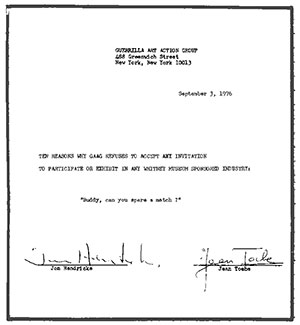
GUERILLA ART ACTION GROUP (GAAG) Letter. 1976.
GAAG used the mails as a means of expressing
opinion on political issues both inside and
outside the art world. Jon Hendricks Collection.
Fluxus has always been a rather unlikely movement: sprightly, hard to pin down, a bit Zen-like in its reluctance to be described, it is hardly a movement at all. One may rather call it a rubric, a forum, an elusive philosophy made real by the fact that real artists engaged one another and the world in real acts under the name Fluxus. The edges of Fluxus have never been particularly crisp or brutal. So it is that Fluxus shares Daniel Spoerri with the Nouveaux Realistes; Christo has occasionally floated into Fluxus, though he has about him always a sense that he can never be part of any particular group with which he may share interests. Half a dozen of the most active and charming participants in the NYCS were very active in Fluxus. At times, even Ray Johnson took part in various Fluxus publications and events.
As elusive and unlikely to proselytize as Fluxus seemed, it also had a very public side. Massive festivals, grand publishing programs, extensive tours of performances and concerts, proposals for social reform and public housing came out of a movement which was as much characterized by these prophetic, even socio-political leanings as by such typically evanescent projects as George Brechts' laconic events.
At first, the Fluxus artists active in the correspondence art world (including many who did not participate in the NYCS) were quite content to create private works. These included mail art pieces by individuals, and marvelous series of publications, post cards, stamps and stationery published by George Maciunas for Fluxus artists including Bob Watts, Robert Filliou, Ben Vautier, Daniel Spoerri, and others among us. There was even a Fluxus Postal Kit prepared in 1966 complete with a Fluxpost cancellation mark, permitting an entire, Fluxus-controlled postal exchange to take place.
By the late '60's, the public opportunities of correspondence art and mail art became manifestly visible. It was then that the prophetic side of Fluxus emerged, establishing the second phase of mail art. Now, for the first time, the correspondence art -in the previous sense that the term has been used here -that reached out to the public, embodied not only correspondence art, but a larger, and admittedly less private, mail-art. Through this outreach, the extraordinary latent power for international communication became overt, termed "The Eternal Network" by Robert Fillou. It was at this time that mail-art first created, and began to make the real, its potential for social change and for contributing new forms of communication to the world.
Having taken counsel by the bad example of self-congratulatory colleagues, I've come to feel a bit uncomfortable writing about my own work. Whereas I first began writing on art to explain my work, or to explain Fluxus, and therefore, in a sense, felt free to write about myself, I prefer now to write about art to explain issues. In that I have been called on for this article to write about Fluxus, and, in particular, Fluxus' relation to mail art, I have, in part, been called on to write about myself. I beg the reader's pardon for that which may seem boastful. The historical documents are available, and, with the forthcoming appearances of Michael Crane's massive study on mail-art, a plethora of documents will be accessible to the public. Where the reader finds me questionable or disagreeable, therefore, I suggest a first hand look at the material to permit each to make his or her own determination. That said, I'll write it as I see it.
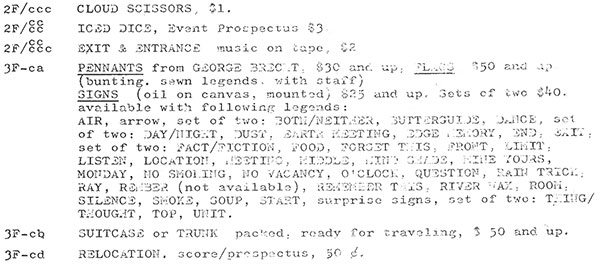
EUROPEAN MAIL-ORDER WAREHOUSE. 1964. This publication of the European Flux Shop is a catalogue with a price list that was meant to be used to order contents. Available items that would be sent through the mails ranged from "Robert Watts: events in a wood box, $3" to "Alison Knowles: canned bean roll $6;" "Fluxus-Machine $5;" "Nam June Paik: exhibits and compositions $8." The catalogue illustrated here was sent to Rober Watts. The Gilber and Lila Silverman Collection.
Fluxus was a forum for experimentation. The commitment to experimentation and to research was profound. It was characteristic that Fluxus participants not only asked "Why?" but "How?" -and then they would generally go on to ask "Why not?" and "How else?" A fair number of Fluxus' members came to art from untraditional backgrounds - Spoerri from ballet, Higgins from music and printing, Paik from music and robotics, Filliou from economics, Brecht from natural and biological sciences, and so on. Others, such as Alison Knowles or Wolf Vostell were trained as artists, yet they developed a highly experimental notion of what art could be. Finally, the ringmaster of the Fluxus circus, George Maciunas, was both pragmatic and experimental. As the chief editor and frequent organizer of Fluxus activities, his paradoxical whims, highly refined organizational sensibility and peculiar administrative quirks gave Fluxus its unique flavor and offered Fluxus artists the wide range of philosophical permissions and encouragements that came to characterize the Fluxus ethos.
At first Fluxus artists took part in correspondence art as private individuals. Some were involved in Nouveau Realisme, some in the New York Correspondence School, some as individual participants on the growing network. By the end of the 1960's, a number of Fluxus people had begun to view mail-art as a medium offering unique potentials and challenges. They saw beyond the basic issue of art through the mail, and began to explore the reaches and media of correspondence and mail themselves.
The first major step was taken by Dick Higgins when he established Something Else Press and the Something Else Press Newsletter. The Press was an innovative publishing house designed to bring experimental and avant-garde work to the public eye in well designed, handsome, durable books. It is by now well known as one of the early sources of much contemporary art. Higgins himself is famed as the essayist who brought, the term "intermedia" into current usage. When Higgins wrote his seminal essay on intermedia in 1966, he sought a format to make it widely known; The form he chose was that of the newsletter.
In his newsletter, he created an inexpensive medium for sharing art and art ideas with thousands of readers. It was through his everexpanding list of readers, book buyers, recipients of the newsletter and the Press' catalogues that Higgins first redefined the mail-art network. This is a significant moment in mail-art, even though Higgins did not entirely view the newsletter as a mail-art format. For the first time, a correspondence artist consciously used the mails as a regular medium of public communication. Even though the newsletter was primarily outbound in its form, there was always a flavor to it that encouraged response and participation, a fact that Higgins' and the Press' voluminous files and archives demonstrate. Higgins' respondents and correspondents moved into the network and into the art world. Staid artists became experimental, and experimental artists came into contact with other experimental artists. Something Else Press, founded as an outgrowth of Fluxus, small, perhaps private in its original conception, became the locus of a vast resonating network of correspondents. It is vital to note the development of a network intended as a forum through which ideas might be exchanged and through which like minds might come into communication. This was a public realization of the idea inchoate in the New York Correspondence School, but never fully realized due to the highly private, personal context that characterized the NYCS.

NAM JUNE PAIK. THE MONTHLY REVIEW OF THE UNIVERSITY FOR AVANTGARDE HINDUISM 1963.
Jon Hendricks collection.
Further, it was through the Something Else Press that the projects of artists such as Robert Filliou, George Brecht, Daniel Spoerri and even Ray Johnson himself first found a broad public.
The next Fluxus contribution to correspondence art and to mail art was the exploration and use of the medium of mail as a communication system. These projects came in three parts. The first had to do with communication, the second with exhibition and the third with publishing.
When Fluxus began, the art world was a smaller place, experimental artists comprised a far less significant faction of the art world. It was difficult to find out who was who or to reach others who might share given interests. In the early days of Fluxus, George Maciunas regularly published the Fluxus mailing lists and membership lists. This permitted ready access to people about whom one might wish to know more. It also suggested to some of us the notion of contacting those whom one didn't know; to find out who they were, what they were doing, and what made them interesting enough to incorporate the Fluxus list.
Starting in 1966, Fluxus West began to publish annual compilations of the Fluxus. lists, adding to those lists interesting artists whom we were able to locate and identify. By 1972, the lists had grown to a point where we published over 1400 names and addresses, together, where possible, with phone numbers. The 1972 list was published in cooperation with Canada's Image Bank. It was released in hundreds of copies, distributed gratis to artists, arts organizations and publishers around the world. The list became the core of the first File Magazine artists' directory, was used to develop Flash Art's· Art Diary, and, in expanded and better researched versions, served such staid reference tomes as Who’s Who in American Art and Who’s Who in America. The project was an act of social responsibility: access to a fuller universe of information in a professional environment marked by restricted communication. The restriction of communication is a tool and a weapon. It gives power to those who possess the media of communication and it works against those who lack rich success. It seemed to us that certain individuals at the center of art world media - critics, curators, dealerscould reach anyone, while the rest of us had a hard time finding jealously guarded mailing lists to reach others. The wide publication of the lists, right or wrong, changed all that. The reference tools and media that grew from our lists had an impact on the art world that was not foreseen when, in order to gain greater control over its own communication, Fluxus West began the annual directory and publications.
The existence of such substantial numbers of people, many - if not most -interested in communicating with one another and experimentally inclined (at least from time to time) suggested new ways of exhibiting art and of preparing exhibitions. The first such notions were rudimentary. It was tough to bring large works of art out of Eastern Europe in crates, but a big drawing or a suite of photos could easily be put in an envelope to be mailed out as a letter, albeit a thick letter. So it was that at first, even as we were using the mail to create experimental works as individual artists, we were also using the mail to transmit fairly ordinary or traditional art works for exhibition. Two or three important exhibitions blossomed simultaneously that were to transform correspondence art and mail-art from private activity to public access. The first projects were the major mail-art shows organized by Marcia Tucker at the Whitney Museum, to which Ray Johnson's personal friends and New York Correspondence School colleagues were invited, and the 1971 Biennal of Paris, curated by French art historian and critic Jean-Marc Poinsot, involving the several dozen figures who were at that time seen as the leading artists in the field.
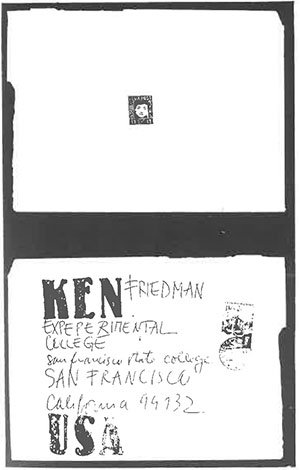
MILAN KNIZAK. AKTUAL. Letter, 1969. This mailing consisted of a single sheet, folded into a rectangle to form an envelope. It opened up to reveal a colored drawing. The lettering of the envelope and FLUXPOST stamp are representative of Knizak's work in the late 1960s. The Gilber and Lila Silverman collection.
At first, the mails were used to create exhibitions or used as a forum for private artists whose interactions were exhibited. The leap to a public process seems to have emerged from an idea that I had after my experience with the lists. I reasoned that the lists themselves might be used as the body of artists invited to exhibit. The notion went through stages. When George Neubert then curator of the Oakland Museum, offered me a one-man exhibition for 1972, I chose a one-year project inviting people to correspond with me through the museum. This invitation started with the use of the lists and grew to become public. A second project was mounted at the University of Washington museum, The Henry Art Gallery, in Seattle. At the Henry Gallery, we addressed the public directly to create enormous regional group participants, incidentally involving participants from afar through extended media and wide public coverage. The final apotheosis was a project entitled Omaha Flow Systems, mounted at the Joslyn Art Museum in the Spring of 1973.
For Omaha Flow Systems, we devised a number of projects and subprojects, using all of the administrative and analytic tools available to us. The show, while serving to model a wide variety of ideas and projects, became best known as the largest mail-art project to date - or since. Thousands of invitations were mailed, and mass media, local, regional, national and international, were used.
Over 20,000 items were received at the Joslyn, with many tens of thousands additional viewer contacts, input/ out-put transactions, systems that we could not trace, satellite exhibitions at other institutions across the region and around the world. The recent histories of mail-art cite the Omaha Flow Systems project as the basic model for all mail-art exhibitions since 1973, and - in its subprojects - as the model for several uses of mail art and correspondence art in both exhibition and other forms. (I must add that in many cases, mail art projects modeled on the paradigm developed in Omaha did not come from Omaha directly. Rather, the model was adapted, say, by an artist from South Dakota who invited a friend from Iowa to participate. The Iowan created a mail-art show that was an inspiration to some artists from Staten Island. The Staten Island show influenced some people in Connecticut, and so on. Further, several shows developed at the same time as Omaha Flow Systems, also using our lists and research, had enormous direct influence. These included, most notably, Davi det Hompson's Cyclopedia, and the several exhibitions organized by Terry Reid and by the Canadian mail-art geniuses at Image Bank.
The publishing paradigm developed developed through Fluxus have had substantial impact on mail art. At first, the notion of newsletters and periodicals was treated playfully, as, for example, Nam June Paik's Review of the University of Avant Garde Hinduism, or Daniel Spoerri's magazine from his Greek island retreat at Simi. Dick Higgins, as already discussed, took a further step with the Something Else Press Newsletter. George Maciunas created the V-Tre newspaper, allied conceptually and physically to the production of Fluxus multiples and concerts. Where the Fluxus publishing ethos came directly into the realm of contemporary mail-art was in Amazing Facts Magazine and with the birth of New York Correspondence School Weekly Breeder.
Amazing Facts Magazine was a crudely assembled publication created at Fluxus West in 1968. We gathered in our mail, put it into a folio with a cover, and sent it out. The idea lasted one issue, but established a notion of gathering as the editorial principle for a magazine. Independently in Germany, Thomas Niggl was creating Omnibus News, the first truly gathered or accumulated magazine in multiple editions. These two preceded the better known Ace Space Company anthologies gathered and published by Dana Atchley, and, finally, the Assembling anthologies developed by Henry Korn, Richard Kostelanetz and Mike Metz, today the best known and most widely disseminated of such periodicals.
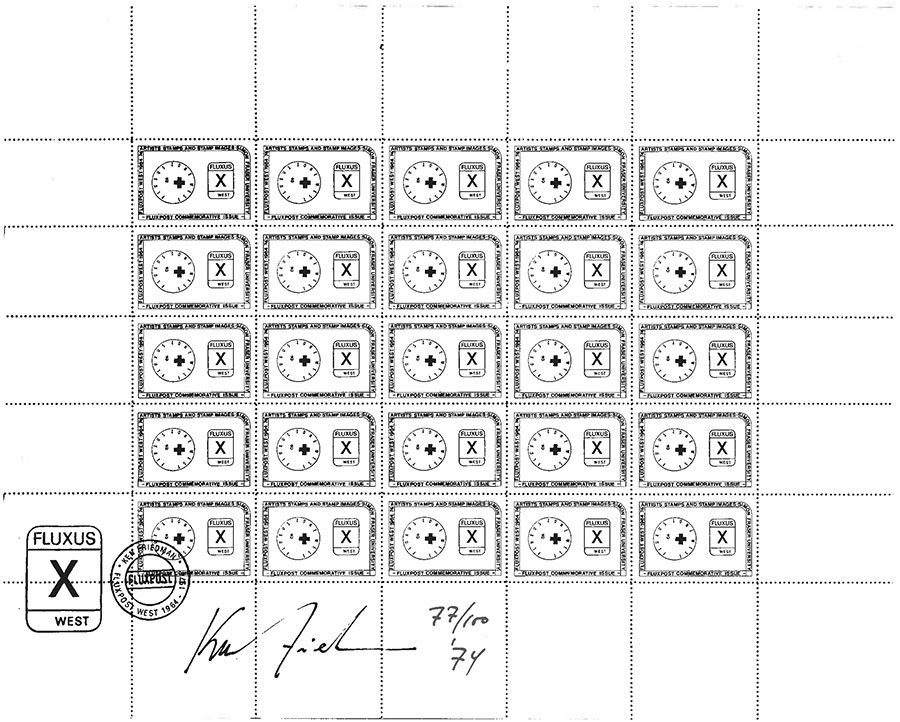
KEN FRIEDMAN. FLUXPOST COMMEMORATIVE ISSUE. 1974. This sheet of stamps celebrates the 10th anniversary of FLUXPOST stamps. Ken Friedman Collection.
More quirky and playful, the New York Correspondence School Weekly Breeder was a jest intended to tickle the sense of youthful fancy one had in school in receiving the My Weekly Reader periodicals, and to create a regular, weekly contact with other artists. The NYCSWB was published through about 10 or eleven issues at Fluxus West, then passed to Stu Horn, a Philadelphia artist. Horn, already well known as The Northwest Mounted Valise, a longtime friend of Ray Johnson and a talented graphic poet, produced a number of issues for the second volume and then passed the periodical to Bill Gaglione and Tim Mancusi in San Francisco. Gaglione and Mancusi took the idea on, and through their network of friends and correspondents, transformed the NYCSWB into an odd - and oddly influential - periodical. Starting with its modest, single-sheet beginnings in 1971, the NYCSWB grew to spark the phenomenon in publishing known as the "Dadazine," a format adopted not only by mail artists, but widely influential for artists books and for publishing in fields as diverse as punk rock and art criticism.
In surveying Fluxus' influence on mail art and correspondence art, the results of a survey reported to be in Mike Crane's forthcoming book is very revealing. Fluxus as a group emerges as the largest single influence, followed by Ray Johnson (2), then by Fluxus artists Ken Friedman (3), Dick Higgins (4), George Brecht (6), Robert Filliou (8), and Ben Vautier (9).
Fluxus approached mail art as an opportunity to experimentation, to communication and to interaction. At the beginning, the Fluxus artists were part of that primary group of individual participants on a small network: at the end, the trenchant experimentation that Fluxus artists pursued, the paradigms they developed and proved redefined the medium, taking it into its third phase and leading to its present state. Mail art and correspondence art have without doubt grown into a new phase, a fourth phase made possible only by a widening public and a generation of new and vital artists. Fluxus' role in the history of the medium was to create the bridge between private and public states, and to develop the new media that today's artists employ in exploring today's issues.
____________
[1] The name itself was coined by Ed Plunkett, then given its broad use by Johnson.
[2] Kurt Schwitters had done stamp works as early as 1918 and the Russian Futurists had achieved the distinction of creating the first modern art with rubber stamps a few years previous. However, the medium vanished until Arman resurrected it in his oeuvre.
